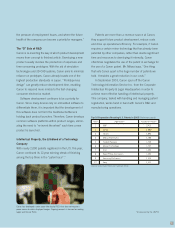Canon 2003 Annual Report Download - page 20
Download and view the complete annual report
Please find page 20 of the 2003 Canon annual report below. You can navigate through the pages in the report by either clicking on the pages listed below, or by using the keyword search tool below to find specific information within the annual report.
Product Group Report
Katsuichi Shimizu
Chief Executive
Inkjet Products Operations
Innovations across the
board last year, in
hardware as well as in
software, enabled
Canon to continue
expanding its inkjet
business in new
directions.
At Canon, we are continuously looking for new ways to
improve the image quality and print speed of our inkjet
printers. Our latest innovation is New MicroFine Droplet
Technology, which is being equipped on a wide range of
our inkjet printers, from multifunction models through to
SOHO and home Bubble Jet models. It has bolstered our
technological lead in the market and drawn outstanding
reviews from our customers.
One of the more exciting developments underway in our
business is in the area of home printing. A host of new
developments is enabling us to raise the image quality of
home printing to the level of traditional film photo printing,
while the PictBridge standard has helped to ensure seamless
direct printing from digital cameras. We’ve had considerable
success marketing ultra-compact printers that allow direct
printing from digital cameras and camera-equipped mobile
phones, and we think the demand for such products,
including micro-printers, will continue to expand.
Consumers, of course, appreciate the “on-demand”
aspect of home printing—they can shoot what they want,
when they want, and not have to worry about involving a
film processor or output center. But just as much, I believe,
people love the DIY, fun aspect of amateur photography
and we’re helping to make that possible in new ways. We
also see the potential for price reduction at the pro end of
the market, and we hope that our technologies here will
trickle down to the prosumer and consumer markets.
By the way, the development of high-grade photo-quality
inks and paper is another way we are successfully boosting
image quality for the home printing market. Needless to
say, this is an important field for us, because the products
are a source of recurring revenue.
On the other end of the spectrum, we have continued
to bring innovation to our large-scale inkjet printers. Posters,
signboards, in-store advertisements and many other small-
run jobs that were traditionally done by offset can be handled
with our inkjet printers.
I’d like to finish by mentioning the utility software that
is supplied with computer peripherals, both printers and
scanners. It forms a vital part of the whole Canon product,
turning it into an integrated customer solution. I’m happy
to say that we’re supporting all major platforms, and we
are doing so in 18 languages, providing simple-to-use
utilities that actually help customers use the hardware
more effectively.
(
From an interview with Mr. Shimizu on January 20, 2004
)
Computer Peripherals
18
























